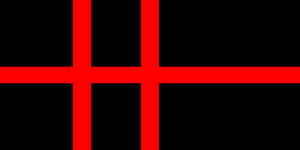Norsefire
| Norsefire | |
|---|---|
  | |
| Appears in | V for Vendetta (comic) V for Vendetta (film) |
| Leader | Presumed vacant; formerly led by Adam Susan (Adam Sutler in film version) |
| Notable members |
|
| Political ideology | |
| Political position | Far right |
| Colours | Black and white (comic) Red and black (film) |
| Slogan(s) |
|
| See also Fictional political parties Politics in fiction | |
Norsefire is the fictional fascist political party ruling the United Kingdom in Alan Moore and David Lloyd's V for Vendetta comic book series. While neither Moore nor Lloyd have said why they chose "Norsefire" as the name for his ruling party (sometimes simply called "the Party") it could be a possible reference to similar entities, like the National Front, who have used the initials "NF" and a flaming torch as their logo. The National Front were particularly strong in the early 1980s, and their paper is called The Flame.
Overview
The story presents a post-apocalyptic Britain that has narrowly avoided an international nuclear war from 1988 on. As displayed during the story of Evey Hammond, although the United Kingdom did not suffer any nuclear attacks, the effects of full-scale nuclear war on other countries had severe effects on the environment, and thus on agriculture. This in its turn severely damaged the British economy and mass riots broke out. As Evey relays to V, an anarchist determined to destroy Norsefire, the government quickly collapsed and chaos overran the country.
The situation turned after several years (approximately 1992 in the story). From the madness of the violence came the ultra right-wing Norsefire regime: fascists[3] (similar to Oswald Mosley's British Union of Fascists) that united with the surviving big companies and businesses, giving them the appearance of wealth and stability. However, while the Norsefire regime did indeed bring order back to the country, this order came at a cost: ethnic and racial minorities such as Black people, Indians, and Pakistanis were rounded up and sent to concentration camps. Religious groups such as Jews, Muslims, and other minorities such as homosexuals and political leftists were also persecuted. With their potential enemies all removed within a short space of time, Norsefire began consolidating their power over the country. They began to sink their influence into the Church of England, giving it more power and influence. They began promoting and demoting members of the clergy as they saw fit. They also took over the television companies, creating NTV (Norsefire Television), and implemented the technologies that would allow for a closely monitored society, including closed-circuit television. In the novel the British monarchy continues under Queen Zara. No reference is made to the monarchy in the film, though God Save the King is played during a television parody sketch.
By the time the story of the graphic novel has begun, Norsefire has shut down the concentration camps and is essentially in complete control of society. Although competition exists between the varying branches of the state (similar to the rivalry between the SS and the SA in Nazi Germany), they generally have complete control over the United Kingdom. The head of the party is Leader Adam Susan, a self-proclaimed fascist who seems to worship Fate, the super-computer surveillance system that oversees the nation. Their control over the state soon faces a threat from V, the anarchist protagonist of the story who seeks to overthrow the regime and allow the people to decide their own fate.
Motto

A common recurring motto is "Strength Through Purity, Purity Through Faith" (or in the movie, "Strength Through Unity, Unity Through Faith"). The British Union of Fascists also used a similar slogan, "Action within unity". Another maxim often used by Norsefire as a salute is "England Prevails".
Film portrayal

Although Norsefire still bear their largely repressive policies in the movie adaptation of V for Vendetta, some differences are worthy of note.
The openly fascist Norsefire comes to power in the film by winning a general election with 87% of the vote. The mechanism is elaborated in the film to a much greater extent than was ever discussed in the comic. However, much of the following explanation comes from Finch's speculation that the biological attacks were a Reichstag fire ploy. His fears are "confirmed" by a discussion with one of the agents involved, but it is later made clear that this was V impersonating the real agent, who has been dead for 20 years, manipulating Finch to get to Creedy. However, much of the plan is confirmed by other sources, especially V's own background.
In place of the nuclear war of the novel version, biological weapons are used instead. Alan Moore later states in the foreword to the trade paperback edition of V for Vendetta that scientists now felt that even a "limited" nuclear war was not survivable. Thus biological weapons would today be considered more plausible. In the film, the men who later became Norsefire had staged a plan that would sweep them into full control of the nation; using detention centres, they conducted horrific medical experiments on prisoners to perfect a deadly virus (and the cure for it) which they then used to stage a terrorist attack they would blame on religious extremists.
To maximise its effect, the virus was released in a water treatment plant called Three Waters, a London Underground station, and the St. Mary's Primary School. The "St. Mary's virus" quickly killed almost 100,000 people in the British Isles, and the British populace was gripped by fear. Several "terrorist" scapegoats were tried and executed. Norsefire then promised to bring back security against the new "terrorist threat". Party leaders had bought stock in the pharmaceutical companies that would later mass-produce the cure, becoming very rich in the process. Not long after the biological attack and their ascension to power, the public was informed that a cure was miraculously discovered and distributed throughout the country. Adam Sutler (the film version of Adam Susan) was then elected to the new office of High Chancellor.
Norsefire still has the primary government divisions of the graphic novel, though these anatomical names are rarely used in the film:
- the Hand with its agents,
- the Finger (the secret police),
- the Eye (the visual surveillance division),
- the Ear (the audio surveillance division),
- the Nose (the police department), and
- the Mouth (the propaganda division, which runs the BTN or British Television Network)
The rest of the world is only passingly mentioned, although it is stated in several news reports that at least the United States (referred to as the "former United States," not unlike "the former Soviet Union") has fallen upon desperate times. According to BTN news broadcasts it is mentioned that the U.S. has become so desperate for medical supplies that it has sent Britain a tremendous amount of grain and tobacco in a bid for aid, and at least by the end of the movie has broken out into its second civil war, although these may be propaganda pieces. It is also unclear whether or not Norsefire controls only England, or whether it also controls the whole country, or even if Britain is still a part of the Commonwealth of Nations. Norsefire's propaganda and the way Eric Finch is mocked by Creedy for having an Irish mother seem to suggest British or Nordic superiority (Storm Saxon, "England Prevails"). (Creedy mentions a devastating outbreak of the Norsefire biological weapon in Ireland, though this may have been accidental.)
The name of the government party, Norsefire, is only used passingly in the film. It is stated in the film that Sutler originally came to power in the Conservative Party, but a chart of election results show that Sutler broke away and formed his own party ("Labour", "Conservative" and "Norsefire" are shown). The computer system "Fate", which played an important role in the graphic novel, is also absent. However, there is talk and use of a new computer network called the Interlink throughout the film.
Sutler, portrayed by John Hurt, is also given visual similarities with Oswald Mosley and Adolf Hitler, having a similar hairstyle, figure, mustache and style of military dress Mosley wore the "blackshirt". However, Sutler is described as having broken away from the Conservative Party, while in real life, Oswald Mosley's New Party, which developed into the British Union of Fascists, was a breakaway from Labour. Adam Susan in comparison, however, is extremely different and shares more similarities with Benito Mussolini.
Symbol

In the book, a blue "N" on a black flag is the symbol of the party. An "N" or "NF" are the only party symbols shown. Yet, as mentioned above, the first issue's cover also features a Greek or Latin cross merged into a pair of wings rising from red flames. This could symbolize the "rise" of Britain from the ashes similar to that of a Phoenix. It is notable that this symbol also uses the British national colours, red, white and blue.
In the film, the Norsefire symbol resembles the Croix de Lorraine. The symbol is shown on flags, police badges, coat of arms, tanks, and army beret badges. Two versions exist, one with a red cross on a black background and another with a black cross on a red background.
See also
- V for Vendetta (1980s comic)
- V for Vendetta (2006 film)
- Ingsoc
- British Union of Fascists
- National Front (United Kingdom)
- Fascism
Notes and references
- ↑ Moore, Alan, Introduction. V for Vendetta. New York: DC Comics, 1990.
- ↑ Madelyn Boudreaux. "An Annotation of Literary, Historic, and Artistic References in Alan Moore's Graphic Novel, V For Vendetta.". An Annotation of Literary, Historic, and Artistic References in Alan Moore's Graphic Novel, V For Vendetta. Retrieved 2008-10-25. "...make Britain great again....This is typically "nationalistic" sentiment.... It was this sentiment, taken to its extremes, that drove Hitler's Nationalist Socialist (Nazi) Workers' Party to try to rid Germany of "non-Germans.""
- ↑ Call, Lewis (1 January 2008). "A IS FOR ANARCHY, V IS FOR VENDETTA". Anarchist Studies 16 (2): 154–172. "V for Vendetta offers a clever, insightful look at the rise of fascism. The fascist 'Norsefire' party takes advantage of the power vacuum which occurs as the liberal British state collapses in the aftermath of the nuclear war."
External links
| |||||||||||
